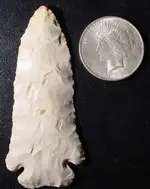Matt- that was a great post, really gets a person thinking. After doing a little more research on the Lyon co. type I would have to agree. Agree on everything except not being able to tell the early hardins and scottsbluff apart but that may be do to the types I see here in central Wisconsin (another regional thing?). The scotts from this area have the same manufacturing style and flaking technologies, often times with super fine collateral flaking but the forms are quite distinct with the scotts dwarfing the kirks in size and the base of the scottbluffs have very shallow and very wide "notches" where as the kirks make you scratch your head and wonder if you should call it an expanded stem or a corner notch. What has caught my attention over the years here is the materials used to make each, we find both scotts and kirks made from hixton most frequently but only scotts made from ryholite. I certainly don't know my typologies as well as you but IMO I believe that most of the kirks we see are descendants of the scottsbluff tradition- I do think that it was kind of a case of punctuated equilibrium though. The scotts lack the variety that the kirks do but they were around as long either and while there seems to be a gradual change in both the manufacturing style and form of the kirk over time there is still that missing link right at the scottsbluff and kirk junction, I would argue that it's due to a fairly abrupt change in the environment at the time, the disappearance of the mega fauna, the warming of the continent, etc etc...alright, now I'm just rambling to, sorry. Bottom line, that's a nice looking point you have there!




